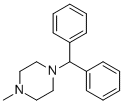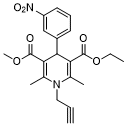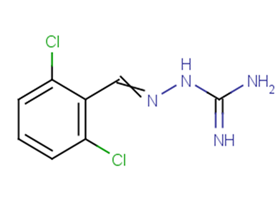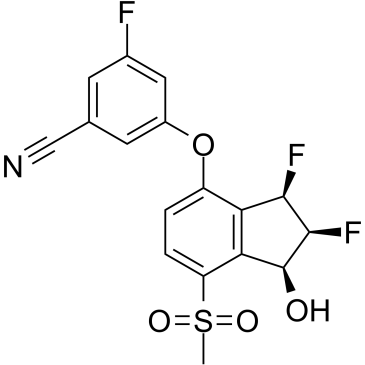 To enhance service speed and avoid tariff delays, we've opened a US warehouse. All US orders ship directly from our US facility.
To enhance service speed and avoid tariff delays, we've opened a US warehouse. All US orders ship directly from our US facility.
| Cat. No. | Product Name | Field of Application | Chemical Structure |
|---|---|---|---|
| DC71259 | GSK2556286 |
GSK2556286 (GSK286) is an orally active inhibitor of M. tuberculosis. GSK2556286 inhibits growth within human macrophages (IC50 = 0.07 μM). GSK2556286 is effective against both multidrug-resistant (MDR) or extensively drug-resistant (XDR) and drug-sensitive (DS) M. tuberculosis.
More description
|

|
| DC71258 | 844-TFM |
844-TFM is a NBTI (novel bacterial topoisomerase inhibitor) DNA gyrase inhibitor, with an IC50 of 1.5 μM. 844-TFM exhibits bactericidal properties against M. abscessus.
More description
|

|
| DC71257 | HXR9 hydrochloride |
HXR9 hydrochloride is a cell-permeable peptide and a competitive antagonist of HOX/PBX interaction. HXR9 hydrochloride antagonizes the interaction between HOX and a second transcrip-tion factor (PBX), which binds to HOX proteins in paralogue groups1 to 8. HXR9 hydrochloride selectively decreases cell proliferation and promotes apoptosis in cells with a high level of expression of the HOXA/PBX3 genes, such as MLL-rearranged leukemic cells.
More description
|

|
| DC60207 | N-(1,2-Dimethylbenzimidazol-5-yl)-1-[(3-fluorophenyl)methyl]pyrrolo[3,2-c]pyridine-2-carboxamide Featured |

|
|
| DC60205 | N-[(6-methylpyridin-2-yl)methylideneamino]pyrrolidine-1-carbothioamide Featured |

|
|
| DC60204 | Hydrazinecarbothioamide, N,N-diethyl-2-[(6-methyl-2-pyridinyl)methylene]- Featured |

|
|
| DC42943 | VU0360172 Hydrochloride Featured |
Potent mGluR5 PAM modulator
More description
|

|
| DC33008 | CP-24879 hydrochloride Featured |
CP-24879 hydrochloride is a D5D/D6D dual-inhibitor, showing beneficial effects against increased intracellular lipid accumulation and inflammatory injury in hepatocytes.
More description
|

|
| DC70409 | FGIN-1-27 Featured |
FGIN-1-27 is an anxiolytic compound that acts as a selective agonist at the peripheral benzodiazepine receptor (TSPO).FGIN-1-27 inhibited Th17 cell differentiation, significantly downregulated the expression of RORγt target genes, notably Il17a, Il17f, Il23r, Ltb4r1,Ccr6.FGIN-1-27 protected mice against EAE, induced amino acid starvation response (AAR), FGIN-1-27 produced anti-anxiety and anti-panic effects in non-mammalian models.
More description
|

|
| DC71156 | SR2640 hydrochloride Featured |
SR2640 (hydrochloride) is a potent and selective competitive leukotriene D4/leukotriene E4 antagonist. SR2640 can be used for researching the role of leukotrienes in human asthma.
More description
|

|
| DC25013 | ARM-1 Featured |
A novel LTA4 hydrolase (LTA4H) inhibitor that inhibits LTB4 synthesis in human neutrophils with IC50 of 0.5 uM.
More description
|

|
| DC22768 | MP07-66 Featured |
A novel FTY720 analog that acts as PP2A activator, disrupts the SET/PP2A interaction devoid of immunosuppressive effects leads to the reactivation of PP2A.
More description
|

|
| DC49919 | FEN1-IN-SC13 Featured |
FEN1-IN-SC13 is a potent DNA fragmentation endonuclease 1 (FEN1) inhibitor (CN106692155A, SC13).
More description
|

|
| DC47376 | Rimtuzalcap Featured |
Rimtuzalcap (CAD-1883) is a first-in-class selective positive allosteric modulator of small-conductance calcium-activated potassium channels (SK channels). Rimtuzalcap can be used for the research of movement disorders including essential tremor (ET) and spinocerebellar ataxia (SCA).
More description
|

|
| DC43041 | CHR-6494 TFA salt Featured |
First-in-class Haspin inhibitor with a wide spectrum of anticancer effects
More description
|

|
| DC32826 | AM-2232 Featured |
AM-2232 is a drug that acts as a potent but unselective agonist for the cannabinoid receptors.
More description
|

|
| DC48532 | Tocainide Featured |
Tocainide hydrochloride is an orally activesodium channel blocker, it blocks the sodium channels in the pain-producing foci in the nerve membranes. Tocainide hydrochloride is a primary amine analog of lidocaine, can be used for the treatment of tinnitus.
More description
|

|
| DC22223 | SB02024 Featured |
SB02024 is a novel highly potent, selective, ATP competitive, orally active inhibitor of vacuolar protein sorting 34 (Vps34) with Kd of 1 nM, >1000 times selective towards other PI3K isoenzymes; SB02024 is also highly selective at 1 uM in the DiscoveRx ScanMax panel of 468 kinases; reduces the number of GFP-2xFYVE puncta with IC50 of 14 nM, induces a dose-dependent increase in levels of NCOA4 and p62; blocks autophagy in vitro and reduces xenograft growth of two breast cancer cell lines, MDA-MB-231 and MCF-7; also significantly potentiates cytotoxicity of Sunitinib and Erlotinib in MCF-7 and MDA-MB-231 in vitro.
More description
|

|
| DC47622 | Cyclizine Featured |
Cyclizine is a piperazine first-generation antagonist of histamine 1 receptor.
More description
|

|
| DC20220 | MRS-1845 Featured |
MRS 1845 is a potent calcium channel protein inhibitor and inhibits capacitative Ca2+ influx in HL-60 cells (IC50 = 1.7 mM).
More description
|

|
| DC21825 | Guanabenz Featured |
Guanabenz (WY 8678) is an α2 adrenergic receptor agonist that is used as an antihypertensive agent, also has been proposed to exert protective effects against misfolding by interfering with eIF2α-P dephosphorylation through selective disruption of a PP1-P
More description
|

|
| DC7232 | PI-103 Featured |
PI103 is a potent inhibitor with low IC50 values against recombinant PI3K isoforms p110alpha (IC50= 2 nM), p110beta (IC50= 3 nM), p110delta (IC50= 3 nM), and p110gamma (IC50= 15 nM), less potent to mTOR/DNA-PK with IC50 of 30 nM/23 nM.
More description
|

|
| DC28756 | J14 Featured |
J14 is a reversible sulfiredoxin inhibitor with an IC50 of 8.1 μM. J14 induces oxidative stress (intracellular ROS accumulation) by inhibiting sulfiredoxin, leading to cytotoxicity and cancer cell death.
More description
|

|
| DC27007 | DDD107498 Featured |
The product is discontinued. DDD107498, also known as DDD 498, is a multiple-stage antimalarial agent that inhibits protein synthesis. DDD107498 demonstrates potential to address a variety of clinical needs, including single-dose treatment, transmission blocking and chemoprotection. DDD107498 was developed from a screening programme against blood-stage malaria parasites; its molecular target has been identified as translation elongation factor 2 (eEF2), which is responsible for the GTP-dependent translocation of the ribosome along messenger RNA, and is essential for protein synthesis. This discovery of eEF2 as a viable antimalarial drug target opens up new possibilities for drug discovery.
More description
|

|
| DC10987 | LTX-315 |
This product is discontinued. LTX-315 (Oncopore) is a synthetic 9-mer anticancer peptide that preferentially permeabilizes mitochondrial membranes, thereby causing partially BAX/BAK1-regulated, caspase-independent necrosis.
More description
|

|
| DC31023 | PT2977 Featured |
PT2977 (MK-6482) is an orally active and selective HIF-2α inhibitor with an IC50 of 9 nM. PT2977, as a second-generation HIF-2α inhibitor, increases potency and improves pharmacokinetic profile. PT2977 is a potential treatment for clear cell renal cell carcinoma (ccRCC)[1].
More description
|

|
| DC41163 | Tigecycline hydrate Featured |
Tigecycline hydrate is a broad spectrum glycylcycline antibiotic. Tigecycline hydrate is bacteriostatic, that inhibits protein synthesis by binding to the 30S ribosomal subunit of bacteria and thereby blocking entry of Aminoacyl-tRNA into the A site of the ribosome during prokaryotic translation. Tigecycline hydrate is active against resistant strains of Gram-positive and Gram-negative bacteria.
More description
|

|
| DC57070 | PY-60 Featured |
PY-60 is a novel activator of YAP-dependent gene expression.It targets ANXA2 in the Hippo pathway.
PY-60 targets ANXA2 to activate YAP[1].
PY-60, a thiazole-substituted derivative, dose-dependently induces luciferase activity in 293A-TEAD-LUC cells in the presence or absence of serum when cells were plated at high cell density (EC50= 1.5 and 1.6 µM, respectively). PY-60 treatment also dose-dependently promoted the association of YAP and TEAD proteins in cells and induced the nuclear localization of YAP in response to increased cell density. PY-60 robustly increases the levels of YAP-controlled transcripts (that is, ANRKD1, CYR61 and CTGF) in 293A cells and other human cell lines (that is, MCF10A, HEK293T, H69 and HaCaT), but did not augment the levels of YAP itself (YAP1)[1].
PY-60 activates a proproliferative, YAP-dependent transcriptional program in the adult animal capable of remodeling the epidermis through proliferation[1].
PY-60 liberates the ANXA2-YAP complex from the cell membrane and competes for ANXA2 binding of phosphoinositides[1].
PY-60 (10 uM; applied topically to the dorsal skin of wild-type adult C57BL/6 mice over the course of 10 days) promotes a dramatic expansion of keratinocytes and K14-positive precursors, as assessed by hematoxylin and eosin and anti-K14 histological staining at the study end. PY-60 results in an approximate doubling of epidermal thickness, a result derived from an increased number of keratinocytes per unit length of skin[1].
More description
|

|
| DC33622 | CG347B Featured |
CG347B is a biochemical.
More description
|

|
| DC80018 | VV116 Featured |
VV116, also known as JT001, is an oral drug candidate of nucleoside analog against SARS-CoV-2. VV116 is a deuterated, tri-isobutyrate ester prodrug of the RDV parent nucleoside, and is rapidly metabolized into the parent nucleoside (116-N1) in the body. 116-N1 is intracellularly converted to the nucleoside triphosphate active form, which would interfere with the function of RNA-dependent RNA polymerase of SARS-CoV-2, thus exerting antiviral effects (Fig. 1). VV116 showed potent activity against a panel of SARS-CoV-2 variants (alpha, beta, delta, and omicron) and excellent therapeutic efficacy in the mice model.
More description
|

|